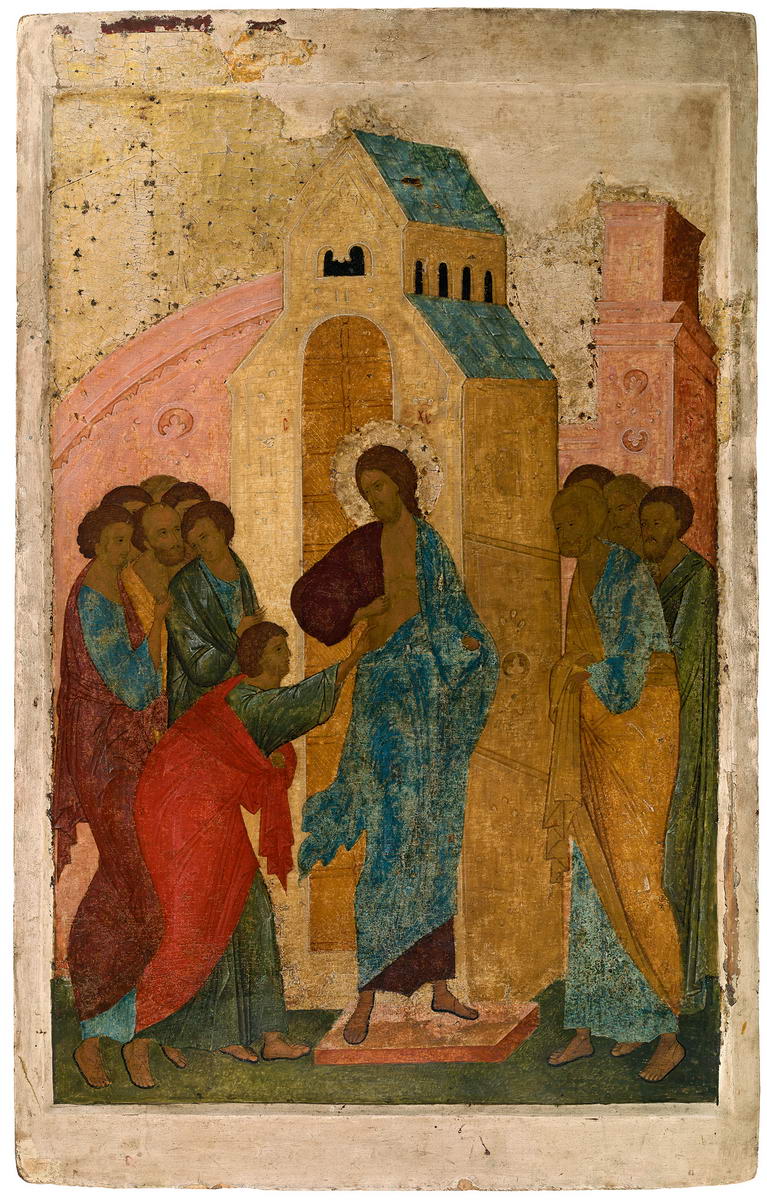


Творчество Дионисия, одного из самых прославленных художников Древней Руси, воплотило духовные и художественные искания своей эпохи и определило развитие основного течения русской живописи второй половины XV и начала XVI века. В северных вологодских землях, недалеко от Ферапонтова монастыря, была расположена Павлово-Обнорская обитель, из которой происходит икона Русского музея.
Сюжет иконы «Уверение Фомы» основан на евангельском тексте и входит в состав изображавшихся в праздничном ряду иконостаса. Православная церковь вспоминает это событие во вторую неделю по Пасхе, которую называют неделей Фомы или Фоминой. В песнопениях этой недели прославляется Воскресение Христа, утверждается истина Его Божества и человечества. На иконе Фома, желая удостовериться в истинности Воскресения Учителя, дотрагивается до Его ран. В его жесте и позе — благоговение, и страх, и восхищение. Его рука потянулась за рукой Христа, а силуэт спины как бы продолжает линию, начало которой — абрис согнутой руки Христа. Фома — под Его рукой, под Его властью, под Его милостивым и понимающим взглядом. Поза Фомы — признание: «Ты еси Господь и Бог мой». Русский музей. От иконы до современности. СПб. 2015. С. 51.
Иконописец, мастер фресковой росписи.
Работал в московском Успенском соборе (1481), расписывал храмы в Чигасовом монастыре в Москве, Пафнутьево-Боровском и Иосифо-Волоколамском монастырях (для последнего написал около 90 икон). Принадлежал к званию "детей боярских", то есть находился на государевой службе. Главное сохранившееся произведение мастера – стенопись собора Рождества Богородицы Ферапонтова монастыря, где он работал в 1500–1502 "со своими чада" – сыновьями Владимиром и Феодосием. Искусство Дионисия развивало рублевские традиции, внося в них особый вклад.С именем Дионисия связан расцвет живописи конца XV – начала XVI веков. Благодаря ему московская школа заняла главенствующее положение в русской живописи.

Dionysius was one of the most famous Old Russian artists. His oeuvre reflected the spiritual and artistic searches of the fifteenth century and dictated the main trends in the Russian painting of the second half of the fifteenth and early sixteenth centuries.
This particular work comes from the St Paul of Obnorsk Monastery, a religious retreat established in the north of Vologda Province not far from the St Ferapont Monastery. The subject of the icon is based on the Gospel story of Doubting Thomas and was included in the festival row of the iconostasis. The Russian Orthodox Church marks the Incredulity of Thomas in the second week of Easter, which is also known as the Week of Thomas. Throughout this week, the Resurrection of Christ is lauded in hymns confirming the verity of His divinity and humanity. The icon depicts Thomas reaching out to touch Christ’s wounds, in order to corroborate His Resurrection. Thomas’ gesture and pose reflect his reverence, fear and ecstasy. His hand reaches out to touch Christ’s hand and the silhouette of his back seems to continue the line of Christ’s bent arm. Thomas is thus simultaneously under Christ’s arm, under His merciful and understanding gaze and under His power. Thomas’s pose is his confession: «My Lord and my God!” (John 20: 28). Russian Museum: From Icons to the Modern Times. Palace Editions, St Petersburg, 2015. P. 51.
Dionysius
Circa 1440 - Before 1508
Old Russian painter of icons and frescoes. Headed a team of artists including two of his sons — Vladimir and Theodosius. Painted the frescoes and iconostasis of the Cathedral of the Dormition in the Moscow Kremlin (1481) and the Cathedral of the Nativity of the Blessed Virgin in the St Ferapont Monastery (1502-03). Created one of the recognised masterpieces of Old Russian icon-painting - The Crucifixion (1500).



